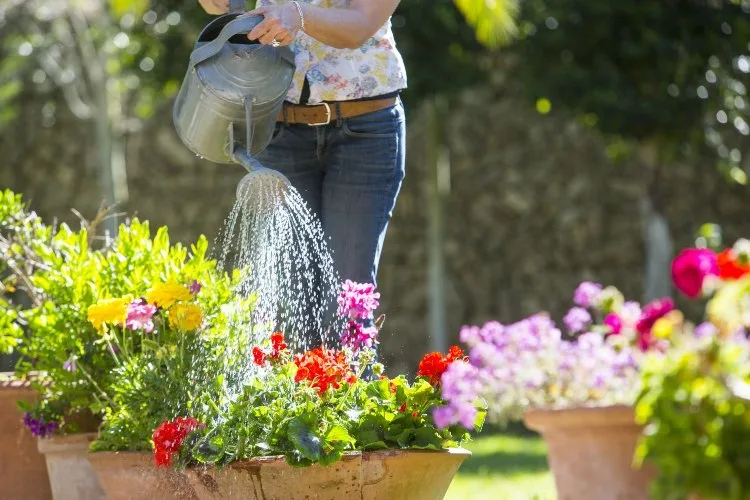Summer has been hot and dry for several years. So that the home garden is not devastated, a few tricks will help when watering. We explain how you can get your plants used to little water and reduce the water requirement. Even thirsty flowers, perennials and grasses thrive in the heat and get through the summer well.
Getting plants used to little water: reduce water requirements step by step
Heat, drought, drought: everything that turns the secluded garden into a devastated landscape. To prevent this, one should regulate the watering, right? Actually, most plants are true survivors and can adapt to longer periods of drought – as long as you support them with the right care.
Regulate the watering
Many hobby gardeners make the same mistake: They regularly give the plants plenty of water. They get used to it and only form short roots that can absorb the irrigation water from the top layer of soil. They cannot withstand prolonged periods of drought and quickly die if you suddenly water them less. On the other hand, it is optimal to water the plants less often, but water them vigorously. There are several basic rules that should be observed:
For young plants, wait until the soil has dried slightly and only then water. The plants are only watered from below, leaves and shoots should remain dry. When it is hot, water more slowly than usual so that the dried soil can absorb the water better. In the case of old plants, wait until they almost let their leaves droop. Only then, also very slowly, water the root area.
Root growth is encouraged by the longer and longer periods of drought. The plants can also absorb moisture well from the lower soil layers and therefore easily defy longer periods of drought.
Only water the plants from below
In long-lasting heat, the plants should only be watered from below. In this way, the water gets exactly where the plants really need it – in the soil. Wet leaves and shoots can cause sunburn and make plants more susceptible to disease. The lawn sprinkler is also of little use – it is not made for shrubs and plants with dense growth.
Getting plants used to little water: Water early in the morning
The right time to water is early in the morning. On the one hand, the water seeps into the lower soil layers in the morning hours and the plants can absorb it better. On the other hand, waterlogging is prevented. Since the upper layer of soil dries slightly by the evening, the plants are less likely to be attacked by fungi, bacteria and mold spores.
If you also regularly loosen the soil, you ensure better absorption of moisture and prevent the rapid evaporation of water.
Mulching in summer: only helps to a limited extent
For now: mulching brings many benefits to garden plants. But only when they are expelled. The mulch layer made of cocoa shells or slate is ideal for young plants, while bark mulch can also be used for older plants. This layer of mulch protects the soil from drying out and keeps the roots cool. Especially in hot weather, it is very important that the root area is well shaded. Incidentally, this can also be achieved by underplanting the shrubs and trees.
remove weeds
Weeds and bedding plants are all too often in competition. Especially when it is hot, weed plants can draw water out of the soil with their long roots. The flowers and perennials then simply dry out, even if you water them extensively and regularly. It is therefore very important that weeds are regularly removed and that weeds are not allowed to take over the garden.
Shade pots and tub plants when it is hot
Pot and container plants have a particularly difficult time in summer. This is because the soil in the bucket dries faster than in the bed. In hot weather, the plants must therefore be shaded additionally. So even if you have true sun worshipers in the pot, you should always keep the root area cool. For this purpose, you can underplant taller potted plants or simply spread a layer of mulch.
You can get the garden plants used to less watering. You just have to consistently follow the following care tips:
1. Avoid root competition between crops. Plant the plants at the necessary minimum distance.
2. Remove weeds.
3. Water early in the morning and only from below.
4. Water young plants more often and never let the soil dry out in the first few weeks.
5. Then gradually regulate the watering. Water less often, but more extensively.
6. In hot and dry conditions, water the plants slowly so that the soil can absorb the water.
7. Mulch the root area or underplant in the case of trees and shrubs.
8. Shade potted plants
